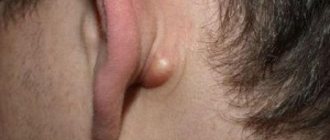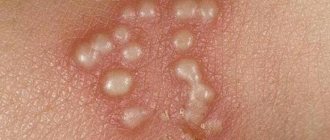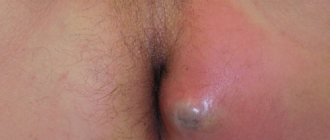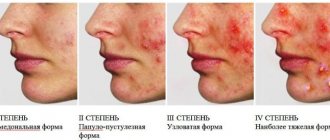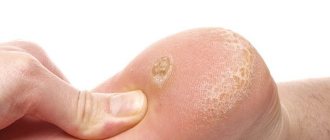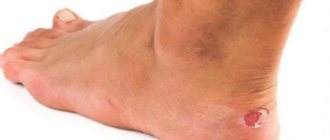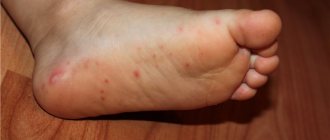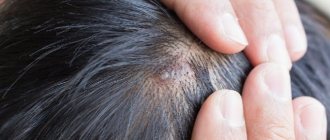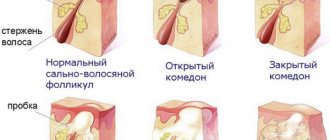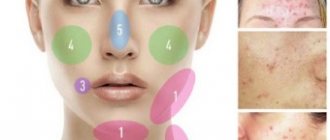Infection of the hair follicle in the anus causes a boil in the anus. In addition, its occurrence is facilitated by weakened immunity, frequent stress, tight clothing and other factors. A person suffering from this problem experiences severe discomfort while sitting and walking. The act of defecation is accompanied by severe pain. If the problem occurs frequently, the pathology must be treated comprehensively. The essence of therapy is to increase local immunity and use antibacterial agents to which the microorganism is sensitive.
In men, the incidence of the disease is 2 times higher.
What it is
A boil is a manifestation of pyoderma (streptoderma or staphyloderma - infection and reproduction of bacteria on the skin: streptococci or staphylococci).
A distinctive feature of a boil from other pustular skin lesions is the shape and size of the rash, the localization of inflammation around the hair follicle and a clear tracing of the stages of maturation and resolution of the infection.
Also, with this disease, the process of suppuration is very active and the volumes of pathological effusion are quite large, which is why boils on the body are popularly called boils or abscesses.
This is what a boil looks like
Most often, the disease is diagnosed in children in early or teenage years, as well as in elderly and elderly patients.
What does a boil look like?
The boil has characteristic external signs:
- at the initial stage - it is a dense cone-shaped infiltrate, which constantly increases in size, reaching 0.5-3.5 cm, the skin around it is red, swollen and painful, patients often call this process: “The boil is ripening”;
- at the stage of resolution, a whitish core is visible in the center of the boil (this is pus and dead cells of the immune system), it rises slightly above the surface of the skin, in this case people say: “The boil is ripe,” and as soon as the purulent contents come out, “The boil has broken through”;
- at the healing stage, a gaping depression remains at the site of the boil, the size of which depends on the area of the lesion; with small boils, they heal without leaving any marks on the skin, and with large boils, scars form.
If for some reason the pus does not come out of the infiltrate, it begins to accumulate under the skin and, as a result, an abscess boil is formed.
It looks like a dense knot, significantly rising above the surface of the epidermis. Pus permeates the surrounding tissues, causing pain, intoxication of the body and triggering the processes of cell necrosis.
Such an abscess requires immediate surgical intervention - it is opened.
Classification of pararectal abscesses
According to the activity of inflammation:
- Acute perirectal abscess - has an acute onset and pronounced symptoms.
- Infiltrative – there is infiltration of surrounding tissues.
- Chronic - fistulas are formed that must be excised surgically.
According to the location of the source of inflammation:
- Subcutaneous abscess
- Submucosal abscess
- Ischiorectal abscess
- Pelvic-rectal abscess
According to the location of the internal opening of the fistula:
- Rear position
- Front location
- Lateral position
According to the depth of tissue damage by the inflammatory process:
- Deep abscess
- Superficial abscess
ICD-10 code
The boil is part of the group of diseases of the skin and subcutaneous tissue.
It has classification and codes according to the localization of the process:
- on the face - L02.0;
- on the neck - L02.1;
- on the body - L02.2;
- on the buttock - L02.3;
- on the arms or legs—L02.4;
- other location - L02.8, L02.9.
A boil can appear on any part of the human body except the back of the hands and feet (palms and soles).
Causes
The main etiology (origin) of a boil is the seeding and rapid reproduction of pyogenic microbes on the skin.
Staphylococcal and streptococcal flora are always present on the human body, but in small quantities, and when exposed to provoking factors, microbial colonies begin to actively grow.
Various reasons can lead to this process:
1. Features of the epidermis, sweating, thermoregulation and sebum formation:
- excessive sweating;
- oily skin;
- constant microtraumatization of the dermis (scratching, picking, rubbing against clothes, etc.);
- skin irritation due to constant contact with dust, smoke, harmful chemicals in production and at home;
- poor body hygiene.
- dermatitis;
- pyoderma;
- erysipelas;
- eczema;
- burns and injuries (wounds, abrasions, cracks).
3. Decrease in the body's defenses:
- after toxic poisoning or serious infections;
- for immunodeficiencies.
4. Taking certain medications:
- steroid hormones;
- cytostatics and chemotherapy courses;
- immunosuppressants during the treatment of autoimmune diseases.
5. Endocrine disorders:
- diabetes;
- pathologies in the functioning of the thyroid and parathyroid glands, adrenal glands, pituitary gland;
- increased production of testosterone in the body.
6. Eating disorders:
- excessive consumption of fatty and sweet foods;
- lack of vitamins and minerals in the diet.
7. Using low-quality or inappropriate care products or cosmetics.
Do you still think that getting rid of hemorrhoids is difficult?
Judging by the fact that you are now reading these lines, victory in the fight against hemorrhoids is not yet on your side.
Have you already thought about surgery? This is understandable, because you have only one internal body, and its proper functioning is the key to health and well-being. Blood on paper, constant thoughts of how to reduce swollen, painful lumps, insomnia, going to the toilet feels like hard labor. All these symptoms are familiar to you firsthand.
But perhaps it would be more correct to treat not the effect, but the cause? We recommend reading the story of Mikhail Sergeevich, how you can get rid of hemorrhoids without harming yourself. Read the article >>
A boil in the anus can occur due to infection and inflammation of the hair follicle. This problem is detected against the background of a weakened immune system, frequent stressful situations, wearing tight clothes and other factors.
Such a formation on the anus causes a lot of trouble. The person experiences pain and discomfort when walking or sitting. Pain is also felt during bowel movements.
If such a phenomenon as a boil on the anus occurs often, then therapy should only be comprehensive. The main emphasis is on improving the body's defenses. The use of effective antibacterial agents is also a prerequisite.
Symptoms
Common signs of a boil are:
- the appearance of skin formation;
- intoxication of the body.
Depending on the location of the purulent process, the boil has some distinctive features in the clinical picture of the disease:
1. On the face. Boils in this area immediately become noticeable and cause great discomfort to patients.
Located in the nose, ear, lips or eye, they cause severe pain when trying to laugh, eat, talk, or wash. In addition, the venous vessels on the face are very close to the surface of the skin and any injury to the boil can lead to the spread of microbes through the blood vessels and the occurrence of thrombosis or sepsis.
2. On the body. Boils often occur on the butt, thigh, or armpit. In the first case, painful sensations occur in patients while sitting and wearing tight trousers, and in the second - when moving the arm and touching the armpit. Patients may be concerned about general weakness, fever, nausea and dizziness.
A boil on the leg or groin is manifested by pain in these areas, itching and twitching sensations, the discomfort usually increases during active movements, walking, squatting or bending.
Therapy
A boil is a disease that occurs in stages, therefore treatment is carried out in accordance with the stage of development of the purulent process:
1. At the initial stage, use:
- a course of penicillin antibiotics;
- injections of staphylococcal toxoid;
- physiotherapy: electrophoresis and ultraviolet irradiation.
2. When the boil matures and the abscess opens, local procedures are added to the treatment:
- mechanical removal of residual pus and dead tissue is carried out and the cavity is washed from the boil with aseptic solutions (salicylic alcohol, boric acid or a solution of furatsilin or hydrogen peroxide);
- a pulling ointment for boils (Vishnevsky, Levomekol or ichthyol) and antimicrobial (salicylic or erythromycin) is used.
3. At the healing stage the following are shown:
- vitamin therapy;
- UHF;
- biostimulants for skin resorption and restoration (with severe scarring).
How to treat boils at home
1. Strengthen the immune system by organizing proper nutrition, a normal work and rest schedule, and getting rid of bad habits.
2. Strictly and systematically carry out personal hygiene of the face and body using suitable care products.
3. You can take anti-inflammatory infusions or teas:
- from chamomile;
- from calendula;
- from yarrow;
- from nettles.
4. To stimulate defenses, the following are useful:
- decoctions of rosehip and chokeberry;
- juices from sea buckthorn and pumpkin.
5. Carrying out local procedures:
- applying an onion cake, which is prepared from one onion in the oven, it is fixed on the boil treated with hydrogen peroxide for 10-15 minutes, the treatment is repeated 4-5 times a day;
- a compress of aloe, a leaf of the plant is cut and applied to the sore spot with the fuzzy side, secured with a bandage for 40-60 minutes, this procedure is done once a day.
The problem is very delicate: it’s embarrassing to show, but something needs to be done.
The phenomenon is common and there are many ways to eliminate this pathology.
But before treatment, you should know the cause of the abscess, otherwise a single boil will develop into a serious disease - furunculosis.
From the article you will learn everything about this disease, which can interfere with everyday life.
Available traditional medicine recipes
The most effective means intended for the treatment of boils are folk accelerators for the breakthrough and release of pus.
For these purposes you can use the following recipes:
- You need to add a few tablespoons of honey to the crushed laundry soap. This mixture is heated in a water bath and stirred until smooth. After this, flour is added to the mixture and a cake is formed to be applied to the affected area.
- The effect of the previous recipe will be enhanced if you use alcohol-impregnated gauze. The cake is placed on top of such a compress, and the top is covered with cellophane and cloth. You need to stay in this state for about 4 hours.
- You can prepare a mixture of honey, flour and goose fat. The compress is applied to the boil overnight.
- If the boil is at the peak of its development, then you can use a proven remedy. To prepare it, you need to chop the garlic, put it on gauze and make a compress, securing it with a bandage. For better effectiveness, you can add a small amount of vegetable oil to the garlic.
- If a boil is just forming, then cut garlic can be applied.
- You can bake the onion in the oven and apply half of it to the boil. You need to keep it for at least 3 hours.
- The best way to clean a wound from purulent masses is to use a saline solution, which is prepared in the proportion of 1 liter of water to 1 spoon of salt. This compress is applied to the boil for a couple of hours.
What are boils and what do they look like?
A furuncle is a purulent abscess that develops in a hair follicle . The process of inflammation occurs with purulent formation and necrosis of the affected tissues. All segments of the population are susceptible to this phenomenon, but people under 45 years of age are especially likely to experience it.
Many people do not know the symptoms of tissue inflammation and mistake a boil for a regular pimple.
Most people try to get rid of it on their own. The consequences of self-medication can be very serious.
How can you recognize a boil:
- You should be alert to painful sensations in the area where the pimple is located.
- When pressed, a compaction is felt.
- A pulsation is felt inside the pimple.
- The skin in the area of the abscess is purple and hot.
Outwardly, they look like a red tubercle with an abscess in the center.
Diagnostics
For diagnosis, as a rule, it is sufficient to collect complaints, anamnesis of the disease and an external examination. In rare cases, especially with a deep location of the abscess, there may be difficulties in differentiating the diagnosis. Then instrumental research methods may be required, for example, computed tomography or ultrasound with a rectal sensor.
In the presence of fistulas, fistulography is performed - staining of the fistula tract to determine its depth, length and direction of the tract.
Laboratory research methods determine the presence of inflammation.
Photo of boils on the butt
In the photo you can see what boils on the butt look like:
Locations
Boils can occur anywhere there are hair follicles. Their appearance on the butt, especially near the anus, between the buttocks, on and around the tailbone is the apotheosis of discomfort. In these areas they form at their maximum size and are accompanied by pronounced symptoms.
A boil near the anus causes very unpleasant sensations. Why do they appear in this area:
- the anus is rubbed by clothes;
- accompanying illnesses;
- weak immunity contributes to the formation of an abscess in the anal area;
- pathogenic microorganisms.
Therapy should only be carried out by a healthcare professional.
Stages of ripening
- The appearance of a purulent core. At this time, the boil is located inside, but it can be recognized from the outside. There is a slight bulge.
- Increase in size. The growth of the boil continues, its size increases. Painful sensations are expressed. The skin near the anus becomes red and itchy.
- The head of the rod is formed. A white dot appears on the surface, the skin becomes thin. It is not recommended to perform any actions with a boil at the time of inflammation.
- Maturation. The inflammation continues, the skin tears and the pus comes out naturally. The process is painful. However, at this time, you should prevent bacteria from entering the wound. It is better to use antibiotics, they can neutralize bacteria in time.
- Hole formation. A small wound appears at the site of the boil.
- Wound healing. The period takes from 7 to 10 days.
Why do ulcers appear?
The main cause of this pathology is bacteria, mainly Staphylococcus aureus. This bacterium is considered very insidious. Having noticed wounds or malfunctions in the functioning of the immune system, it instantly appears in this place of the body.
Boils usually appear on skin that is very sensitive and easily injured. Staphylococcus is “helped” by poor health, which is noted in these cases:
- During the period of restructuring of the hormonal system.
- Poisoning.
- Past infectious diseases.
- Poor food.
- Overheating or hypothermia.
- Stressful situations.
- Ignoring basic hygiene.
Complications
The presence of boils usually does not cause complications, but if left untreated, the infection spreads. As a result of this, there arise:
- Lymphangitis – lymph vessels become inflamed.
- Osteomyelitis - the infection spreads to the periosteum.
- Sepsis - the infection ends up in the bloodstream.
If inflammation occurs in the sebaceous glands, a carbuncle develops, which is a dangerous complication of a boil.
It spreads quickly and develops into other serious inflammations. Therefore, there is no need to blindly trust traditional medicine recipes, but it is better to immediately consult a doctor and begin adequate treatment .
Treatment methods
To properly remove a boil that has arisen on the buttocks, it is not advisable to pierce it with a needle, pick it out, or squeeze it out. This is the prerogative of specialists. Illiterate actions carry the risk of infection, which will result in unpredictable consequences.
Treatment always depends on the stage of the unpleasant phenomenon. Often boils go away on their own, but you should know certain steps to take care of the tumor.
Be sure to treat the affected area with an antiseptic.
Dry heat helps reduce pain. In addition, heating will stop the abscess from maturing.
Conservative
It consists:
The area where redness is noticeable and slight numbness appears does not need to be treated immediately with ointments. Treatment with alcohol is quite sufficient.- When the boil has opened, you need to drop hydrogen peroxide into it and apply a bandage. Vishnevsky ointment will help remove pus.
- After a few days, the pus comes out completely, but treatment should be continued. At this stage, Levomekol ointment is used, which contains an immunostimulating substance and an antibiotic. The drug is very effective in the fight against Staphylococcus aureus.
- If the wound has healed, but a noticeable scar remains, then Contractubex is used. The drug contains substances that soften scars and restore skin tissue.
Operational
If after conservative treatment at home there is no improvement, medical help is needed. Naturally, this must be done if your health worsens and your temperature rises.
After the examination, the doctor will prescribe the appropriate treatment:
- If the abscess does not mature, there is a risk of infection spreading. In this case, a course of antibiotics is prescribed.
- Sometimes you have to open abscesses. The operation is performed with local anesthesia. The abscess is opened, the pus is removed, a medicine is injected into the wound and a bandage is applied.
- During the treatment period, it is advisable to adhere to a special diet.
Folk recipes
Sometimes you shouldn’t ignore time-tested traditional medicine recipes.
- The onion is grated and the resulting gruel is mixed with milk. Cover the boil with a gauze bandage containing this mixture.
- Crushed fresh plantain is applied to the boil.
- Mix rye flour with honey and form a cake, which is then applied to the abscess.
All this is done before opening the abscess.
Furuncle on the buttock
The main causes are:
- Damage to the upper layers of the epidermis.
- Weakened immunity.
An abscess in the gluteal region is a fairly common occurrence, since the skin of this area is sensitive and tender.
Photo 28 - Furuncle between the buttocks
Basically, such boils occur between the buttocks and under the buttock, due to the fact that in these places there are better conditions for the accumulation of the pathogen. To get acquainted with what this abscess looks like, we recommend looking at some of the proposed photos.
Photo 29 - Boil under the buttock
You cannot remove such boils yourself using the squeezing method, as this has its own adverse consequences and complications.
Treatment for an abscess is:
- Conservative (use of ointments and solutions).
- Surgical (by surgical removal, used exclusively in later stages).
- People's
Attention! If you find a hard, internal abscess under your skin and are in doubt about what to do and how to remove it, do not rush to use folk remedies, make an appointment with a qualified specialist for practical advice on how to treat it, he will be able to answer how to treat a boil on the buttocks specifically in your case.
Also, when asked whether it is possible to heat a boil and what antibiotics to use in case of complications, it is necessary to answer that:
- An abscess on the buttocks cannot be heated, as a result of which the situation can be aggravated and the necessary conditions for the development of infection can be created.
Photo 31 - Do not heat an abscess on the buttocks - Antibiotics in the later stages of boil development are prescribed only by the attending physician.
Photo 32 - Only a doctor prescribes antibiotics
Boil on the butt: treatment at home
Of course, most folk remedies cannot help in the fight against boils.
Photo 33 - Vishnevsky ointment draws out pus
Ointments for boils, examples of which are presented above, will be effective remedies.
Photo 34 - Ichthyol helps the boil to mature
You can also apply bandages with a hypertonic solution at home, which will draw pus from the wound.
Photo 35 - Levomekol will help the wound heal after a breakthrough
Important: It is not recommended to use star treatment or squeeze out ulcers.
With timely detection and adequate treatment of boils on the buttocks, you can protect yourself from blood poisoning and even death.
Preventive measures
The main prevention of furunculosis is personal hygiene:
- You should change your underwear daily.
- You need to shower daily.
- After visiting the bathhouse or swimming pool, it is mandatory to take a shower.
Microcracks and wounds on the skin are not mandatory factors for the formation of a boil. It is necessary to strengthen the immune system. Mineral complexes and vitamins will help strengthen the body's defenses.
A boil in the butt area is considered the most painful abscess. He constantly reminds himself of himself with strong discomfort. In some cases, you can get rid of it yourself, but it is better to seek help from doctors. This will not only speed up treatment, but also eliminate the risk of complications.
A furuncle is an unpleasant pathology and occurs quite often. It is important for patients to know the causes, principles of treatment and prevention, which will help in the fight against the disease.
Furuncle on the tailbone
Treatment of boils on the tailbone is carried out according to the same scheme as in the butt area. Initially, ointments (ichthyol or Vishnevsky) are used, as well as UV radiation. These therapeutic methods allow you to quickly open the abscess.
Photo 18 - Furuncle on the tailbone
Then, after the rod is formed, in the second stage, the surgeon can open the abscess and treat the wound with an antiseptic. Next, you will need to carry out dressings using such products in the form of: a solution such as “furatsilin” and antibacterial ointments, for example, “Levomekol”.
Photo 19 - Levomekol promotes healing
Important! If the boil opens on its own (pus begins to ooze out on the tailbone), you can use hydrogen peroxide, a hypertonic solution and Levomekol ointment. The simplest hypertonic solution is water with salt. It is desirable that it be in a ratio of 1:10. Bandages with this product can be applied at night.
If you have doubts about the stage of development of the boil, you must contact the appropriate doctor, who will offer the best option for how to treat the abscess individually for you.
Photo 20 - The doctor will select an effective treatment
What are boils and furuncles?
The acute purulent-necrotic process of the hair follicle and the tissue around it is called a boil (popularly called a boil). Formations can form in any area of the skin, but areas where there is a large amount of hair and strong friction occur are especially susceptible (this applies to the armpits, groin area, buttocks).
In the affected area, hyperemia initially appears, swelling forms, and pain gradually increases.
Anal bumps and hemorrhoids
Pain in the anus is associated not only with a boil. Hemorrhoids can also be felt, like a nodule or pimple. It appears when excessive straining during bowel movements, prolapse of internal organs, and varicose veins of the rectum. Lumps can refer to benign and malignant tumors, for example, growths due to the herpes virus. Therefore, any pathology should be a reason to contact a proctologist.
The most common causes of pain in the anorectal area include:
- Exposure of feces and their bacteria to the skin due to poor hygiene. The infection can infect the skin of the anus and even the mucous membranes with prolonged contact.
- Improper hygiene and the use of hard paper can lead to hair follicle separation and infection, excessive friction and skin irritation.
- Straining during bowel movements causes excess pressure, which leads to swelling of the anal blood vessels.
- A diet low in fiber causes constipation, which hardens the stool and makes it necessary to strain.
- Hereditary factors can cause the development of various neoplasms in the anus.
Finding the source of the disease allows you to determine how to treat the infection correctly.
Causes of appearance in the anus
The cause of a boil near the anus is bacteria from the genus Staphylococcus. They are constantly present on the skin of the body, only a small percentage are pathogenic forms. If you have a healthy body, there is no need to worry. But in cases where weakening occurs due to various reasons, the risk of pathology becomes very large.
The mechanism of occurrence of a boil on the anus is associated with an inflammatory process in the area of the hair follicle when the integrity of the skin is damaged .
Read about intestinal diagnostic methods here.
The anus is always at risk of developing boils, since a large number of pathogenic microorganisms accumulate in it all the time. Constant contact with clothing and friction of the intergluteal folds when walking leads to additional damage to the skin.
Patients with reduced protective properties of the body are at risk. This occurs under the following conditions:
- The presence of severe concomitant diseases of infectious etiology in patients (including chronic pathologies).
- The body weakens due to oncological processes, hormonal and autoimmune disorders.
- Prolonged stressful situations can also provoke the appearance of a boil.
- Poor nutrition and bad habits of patients weaken the body.
- Increased sweating provokes irritation of the skin, the patient experiences a feeling of itching. Scratching the affected area provokes the appearance of microcracks through which the hair follicles become infected.
- Failure to comply with personal hygiene rules in many cases is the main etiological factor in the occurrence of boils.
- Taking certain medications (for example, glucocorticoids or cytostatics) weakens the functions of the immune system. In such a situation, the body is not able to provide adequate resistance to the penetration of pathogenic microflora.
Treatment and prevention
Treatment should only be carried out by a doctor, otherwise complications cannot be avoided, many of which can pose a danger to patients. In situations where a boil appears near the anus, the patient’s recovery time is delayed, since caring for the skin of this area is quite labor-intensive. The duration is usually 3 to 4 weeks.
Large formations require surgical opening with the installation of drainage to drain the purulent contents. With this design it is convenient to carry out hygienic treatment of the affected area.
Surgical treatment of a boil near the anus is also prescribed in case of a protracted opening process, if conservative treatment is ineffective. Intervention should be carried out in situations where the general condition of the patient’s body deteriorates.
Where is the colon located and how does it hurt? Read in this article.
After surgery, a course of broad-spectrum antibacterial drugs and physical therapy sessions are required. These techniques promote rapid healing of boils in the anus, photos of which after treatment confirm this.
If the formations are small in size, it is enough to constantly treat them with gauze turundas soaked in an alcohol solution.
After opening the boil, it is wiped with a solution of hydrogen peroxide. Gauze bandages with medicinal agents must be applied to the affected area. Ichthyol ointment and Vishnevsky ointment, as well as Levomekol, are suitable for this.
These drugs for topical use have an anti-inflammatory and antibacterial effect and promote rapid tissue healing.
During treatment, the patient should completely stop drinking alcohol, smoking, eating spicy, fried, salty foods, spices and sweets.
Prevention of the disease implies constant adherence to the rules of personal hygiene. For such patients, it is better to remove hair from this area using methods that allow you to get rid of it for a long time.
It is important for patients to sanitize other sources of chronic infection of the body, to transform concomitant pathologies into a compensated form.
It is recommended to get rid of bad habits, eat a healthy and balanced diet, and periodically take vitamin complexes and immunomodulators.
Only following these recommendations on an ongoing basis will help patients minimize the risk of developing the disease in the future.
Find out from this article how to treat anal fissures with ointment.
Hemorrhoids: 3 treatment methods + the best recipes
As we have already said, hemorrhoids are sac-like formations that form due to varicose veins in the anorectal area. But here it also needs to be said that, depending on the location of these bumps, there are three forms of hemorrhoids, namely:
- internal - when the bumps are located inside the rectal canal;
- external - when cones are formed from the saphenous veins located around the anus;
- combined - when the veins hypertrophy both inside the anal canal and around the anal ring.
The main reason why hemorrhoids may appear is stagnation of blood in the pelvic area, or more precisely in the vessels of the rectum and anal area. The venous vessels of the anorectal region become overfilled with blood, as a result of which their walls lose tone and become deformed over time.
Dystrophic changes in hemorrhoids are observed not only in the venous wall, but also in the muscles of the rectum. As a result of such changes in the muscles of the anal canal, hemorrhoidal cones can no longer be held inside the rectum and begin to fall out, and in advanced cases they lose the ability to be set back.
Weakening of the tone of the walls of the venous vessels of the anorectal region can be either congenital or develop under the influence of trigger factors. Most often, the following factors provoke venous insufficiency in the vessels of the rectum and anal area:
- “sedentary” lifestyle, when a person spends most of the day in a sitting position. Basically, this lifestyle is typical for such professions as driver, programmer, clerk, teacher, cashier or salesman;
- chronic constipation or diarrhea;
- excessive enthusiasm for diets or unbalanced nutrition, when the diet is poor in plant fiber;
- genetic predisposition, when close relatives also suffer from hemorrhoids or varicose veins of the lower extremities.
- bad habits, in particular alcohol abuse;
- physical labor associated with heavy lifting;
- oncological diseases of the pelvic organs;
- cirrhosis of the liver;
- heart and vascular diseases;
- pregnancy and childbirth.
All of these factors lead to stagnation of blood in the pelvic vessels. The risk of developing hemorrhoids increases significantly if the patient has several factors from this list.
Hemorrhoids came out: symptoms
With internal hemorrhoids in the initial stages of the disease, the node is small in size and located inside the rectum, so in most cases they do not make themselves felt. But you still need to be attentive to your health and pay attention to the following symptoms:
- discomfort in the anal canal;
- feeling of incomplete bowel movement;
- itching in the anus, especially after bowel movements;
- minor painful sensations after visiting the toilet “in a big way”;
- the appearance of traces of blood on stool or toilet paper.
If left untreated, hemorrhoids become larger and the rectal muscles become overstretched. As a result of these processes, internal hemorrhoidal cones sag outward through the anal ring.
The above symptoms increase and become permanent. Constipation also becomes more frequent, since hypertrophied hemorrhoidal veins make it difficult for stool to move through the rectal canal.
External hemorrhoids are easy to identify from the first days of the disease, since you can independently see enlarged veins around the anus. With this form of hemorrhoidal process, the same symptoms will be present as with internal hemorrhoids.
With advanced hemorrhoids, the risk of complications increases significantly, including anal tears, pinching of hemorrhoidal cones, their thrombosis and necrosis. These complications are so painful that patients cannot move, sit or even lie down.
When hemorrhoidal cones are pinched in the anal ring, they become purple with a blue tint and swell. If therapeutic measures are not taken in time, necrosis of the strangulated tissue may develop.
Is it possible to straighten a hemorrhoid on your own?
Hemorrhoidal cones begin to fall out in the second stage of hemorrhoids during bowel movements. After defecation, the nodes are independently retracted into the anal canal under the influence of the muscles of the anorectal region.
At the third stage of hemorrhoids, sagging of the hemorrhoids occurs not only during bowel movements, but also during physical activity, which increases the pressure inside the abdominal cavity. Coughing, sneezing, laughing, carrying a heavy object, deep squatting or passing gas can cause the cones to fall out.
If such a situation occurs and there is no way to contact a specialist, then you can try to return the hemorrhoidal cones inside the anal canal yourself, because the prolapsed node hurts a lot and can become dead.
When performing such a manipulation, you need to be extremely careful and careful, following the following instructions:
- wash your hands thoroughly with soap and treat with an antiseptic, such as medical alcohol;
- wear sterile latex gloves;
- to reduce pain, apply an antihemorrhoidal ointment with an anesthetic (Relief Ultra, Procto-Glivenol, Olestesin) or apply a compress with a cold decoction or chamomile infusion for 15-20 minutes;
- when the pain in the anus decreases, get on your knees, spreading them wide, and bend forward;
- lubricate the middle finger of the hand on the side of the fallen bump with Vaseline;
- With one hand, spread the buttocks, and with the middle finger of the other hand, gently and carefully push the fallen lump into the anus. When the hemorrhoid is in place, you will feel relief;
- after adjusting the knot, lie on your side, squeeze your buttocks and stay in this position for about 40 minutes.
Hemorrhoidal cones cannot be reduced if they are pinched in the anus, a blood clot has formed in them, or necrosis has developed.
If, after reduction, the hemorrhoid continues to hurt or falls back out, then these may be signs that the disease has already crossed the border of the fourth stage. In this case, self-medication is strictly prohibited. Only a specialist knows how to remove hemorrhoids without harming your health.
Hemorrhoids can be cured only with the help of a whole range of therapeutic measures. To do this, experts use the following methods:
- diet therapy;
- use of conservative agents;
- surgical treatment of hemorrhoids.
In the initial stages of hemorrhoids, when hemorrhoidal cones do not yet fall out of the anus, treatment consists of following a diet and using anti-hemorrhoidal drugs, ointments, gels or suppositories. When the bumps begin to fall out, a specialist may recommend removing them using minimally invasive surgical techniques.
In advanced cases, conservative therapy is powerless, so the only radical method is hemorrhoidectomy.
Next, we propose to consider each component of the complex treatment of hemorrhoidal cones in more detail.
How to treat hemorrhoidal cones with diet?
Diet is one of the most important components of the complex treatment of hemorrhoids, since disruption of the intestines is one of the trigger factors for inflammation of hemorrhoidal cones.
Patients with hemorrhoids should adhere to the following dietary principles:
- eat regularly 5-6 times a day in small portions;
- It is strictly forbidden to go hungry;
- maintain sufficient water balance - at least 1.5 liters of clean water per day;
- the diet must necessarily include foods high in plant fiber (vegetables, fruits, cereals, herbs, 2 tablespoons of bran);
- do not forget about fermented milk products;
- Harmful foods and those that lead to constipation and flatulence are excluded from the diet: fried, smoked, spicy, salty and fatty foods, fatty meats, fish and poultry, white bread, pastries, sweets, pasta, hard cheese, white cabbage, radish, radish, sorrel, grapes;
- Strictly avoid drinking alcoholic beverages.
Hemorrhoids: treatment with conservative means
Only the attending proctologist should select medications for hemorrhoids, since each drug has a strict list of indications and contraindications. Self-medication does not always give the expected result, and sometimes can cause side reactions that are dangerous to health and life.
In the fight against hemorrhoidal cones, both systemic and topical medications are prescribed.
Hemorrhoids can be treated using the following groups of drugs:
- venotonics . Drugs in this group help eliminate congestion in the rectal area by increasing the tone of the walls of the venous vessels. In this case, tablets such as Detralex, Venarus, Phlebodia 600, Aescusan and Venarus are highly effective;
- angioprotectors . The most effective drugs for hemorrhoids are Troxevasin, Vazonit and Pentoxifyline. These products strengthen the walls of the veins, improve microcirculation in the anorectal area and accelerate tissue restoration;
- non-hormonal anti-inflammatory drugs : Nimesil, Ibuprofen and Voltaren;
- laxatives _ The use of laxatives is indicated for chronic constipation, if it is not possible to normalize intestinal function through diet;
- antihemorrhoidal ointments and gels . The indication for the use of ointments and gels is external hemorrhoids. But most drugs come complete with an applicator that allows you to introduce an ointment or gel into the anal canal, so they can be used for internal localization of hemorrhoidal cones. The following ointments and gels are especially popular: Relief, Relief Advance, Relief Ultra, Procto-Glivenol, Posterisan, Hepatrombin, Troxevasin and Proctosedyl;
- antihemorrhoidal suppositories . Rectal suppositories are mainly used when hemorrhoids are located inside the rectum. Suppositories help reduce the intensity of hemorrhoid symptoms and also normalize blood circulation in the vessels of the anorectal area. Most often, experts prescribe the following rectal suppositories: Relief, Relief Advance, Relief Ultra, Procto-glivenol, Olestesin, Proctosedyl, Anuzol, Natalsid, Ultraproct and others.
How to remove hemorrhoids using minimally invasive techniques?
Recently, minimally invasive surgical methods have gained great popularity due to their effectiveness, low trauma, painlessness and short rehabilitation period.
Cones from hemorrhoids can be eliminated using the following methods:
- ligation (tying) of nodes with latex rings;
- destruction of cones with liquid nitrogen;
- sclerosis of hypertrophied hemorrhoidal veins;
- coagulation of cones with laser or infrared rays;
- disarterization (ligation of vessels that deliver blood to the cones).
Unfortunately, the listed methods are effective only in the initial stages of hemorrhoids. In the later stages of the disease or if the disease does not go away with conservative therapy, a radical operation is performed - hemorrhoidectomy.
How to cure hemorrhoids in the later stages?
At the third and fourth stages, the internal and external cones are completely removed along with part of the rectal mucosa, after which tissue plastic surgery is performed. This operation is called hemorrhoidectomy. There are many variations of this operation, but the essence is the same for all.
Hemorrhoidectomy is a large and painful operation that requires a long recovery period. Before surgery and at the postoperative stage, patients are also prescribed antihemorrhoidal drugs, which we described earlier.
How to treat hemorrhoids with folk remedies?
Traditional healers today can offer a whole arsenal of unconventional remedies, with the help of which, according to them, hemorrhoids can go away.
But here you need to think clearly and understand that no matter how natural the folk remedy is, it is not effective enough to cope with hemorrhoidal cones.
Therefore, if you decide to try this treatment, consult your doctor in advance.
There are the following traditional medicine methods for the treatment of hemorrhoids:
- microenemas with decoctions of medicinal plants (chamomile, yarrow, onion peel, oak bark, calendula and others), propolis extract, aloe juice, potato, beetroot, etc.
- baths. This procedure can also be carried out with infusions and decoctions of medicinal plants, cold water, a solution of potassium permanganate, mumiyo and other natural medicines;
- ointments, which consist of lard, butter, propolis, mumiyo, honey, juice of medicinal plants and root vegetables, tar and other natural ingredients;
- candles. Rectal suppositories are very easy to prepare at home. For this, raw potatoes are most often used. Ice candles, which are made from water, infusions and decoctions of medicinal plants, are also very popular;
- hirudotherapy is the use of medicinal leeches that take blood from hemorrhoidal cones and dissolve blood clots. This method should only be carried out by a specialist.
As a result, I would like to emphasize once again that a timely visit to a proctologist not only allows you to stop the progression of the disease, but is also a reliable prevention of its complications. Therefore, do not try to deal with hemorrhoidal cones on your own; leave this matter to a specialist.
